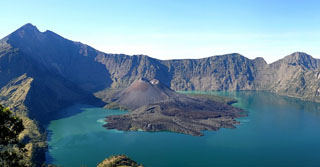Report on Rinjani (Indonesia) — 19 May-25 May 2010
Smithsonian Institution / US Geological Survey
Weekly Volcanic Activity Report, 19 May-25 May 2010
Managing Editor: Sally Sennert.
Please cite this report as:
Global Volcanism Program, 2010. Report on Rinjani (Indonesia) (Sennert, S, ed.). Weekly Volcanic Activity Report, 19 May-25 May 2010. Smithsonian Institution and US Geological Survey.
Rinjani
Indonesia
8.42°S, 116.47°E; summit elev. 3726 m
All times are local (unless otherwise noted)
According to news articles, three eruptions from Rinjani during 22-23 May were accompanied by tremors. Ash and incandescent material was ejected as high as 2 km. Ash plumes drifted 12 km and caused ashfall in multiple areas. Lava flowed into the caldera lake and caused the lake water temperature to rise from 21 to 35 degrees Celsius.
Geological Summary. Rinjani volcano on the island of Lombok rises to 3726 m, second in height among Indonesian volcanoes only to Sumatra's Kerinci volcano. Rinjani has a steep-sided conical profile when viewed from the east, but the west side of the compound volcano is truncated by the 6 x 8.5 km, oval-shaped Segara Anak (Samalas) caldera. The caldera formed during one of the largest Holocene eruptions globally in 1257 CE, which truncated Samalas stratovolcano. The western half of the caldera contains a 230-m-deep lake whose crescentic form results from growth of the post-caldera cone Barujari at the east end of the caldera. Historical eruptions dating back to 1847 have been restricted to Barujari cone and consist of moderate explosive activity and occasional lava flows that have entered Segara Anak lake.
Source: RTT News

